Common menu bar links
Breadcrumb Trail
ARCHIVED - Immigration and Refugee Board of Canada
 This page has been archived.
This page has been archived.
Archived Content
Information identified as archived on the Web is for reference, research or recordkeeping purposes. It has not been altered or updated after the date of archiving. Web pages that are archived on the Web are not subject to the Government of Canada Web Standards. As per the Communications Policy of the Government of Canada, you can request alternate formats on the "Contact Us" page.
Section 2: Analysis of Program Activities by Strategic Outcome
This section provides performance information on the IRB's plans, expected results and financial and human resources presented in its 2007-2008 Report on Plans and Priorities (RPP). Using the IRB's PAA and MRRS that were approved by TBS for the 2007-2008 reporting period, the section details the achievement of the Board's strategic priorities and strategic outcome.
Table 2.1: The IRB Program Activity Architecture
The 2007-2008 IRB Performance Report is the second time that the IRB uses the complete performance measurement framework to report on its strategic priorities and outcome. The investment in developing the framework and populating it with performance indicator data provides an improved foundation for this performance report. The IRB ensures it is focused on results, delivers value for money, is consistent with Government priorities, and continues to serve the purpose and mandate for which it was created.
Common Elements
The IRB has developed an Integrated Business Plan (IBP) for 2007-2008 that brings together the plans and expected results for its four program activities. The plan identifies both the common and distinct areas of activities for each program activity. Presented in this section are the performance results for the common elements and for each of the decision-making program activities. The performance results for the Corporate Management and Services program activity are presented in Section 4.
Table 2.2: Common Elements Plans and Results
|
Common Elements: Plans and Results for 2007-2008 |
|
| Strategic Outcome: Provide Canadians with well-reasoned decisions on immigration and refugee matters efficiently, fairly and in accordance with the law | |
|
Strategic Priority 1 Consolidate the integration of the work of the Board's divisions to ensure quality, consistency and fairness in the efficient resolution of cases in a time of transition |
|
| Plans | Results |
| Policy Instruments and Procedures | |
| Elaboration of IRB detention/security framework and implementation of selected elements across the divisions |
|
| Initiate the development of a common/shared policy on the use of videoconferencing and new technology |
|
| Develop and implement IRB policy governing conduct of representatives |
|
| Case Management Strategies | |
| Implement integrated adjudicative support model |
|
Cross-divisional integration initiatives:
|
|
| Performance Measures | |
| Continue to develop and refine a standardized approach to present IRB divisional reports, including meaningful cross-divisional indicators, both quantitative and qualitative |
|
|
Strategic Priority 2 Continue to build an organization that strengthens its operational and leadership capacity, its diversity and its flexibility |
|
| Plans | Results |
| Adjudicative Culture | |
| Pursue recruitment efforts of GICs for RPD and IAD |
|
| Review and deliver comprehensive new decision-maker training in light of anticipated renewal of workforce� |
|
| Develop and implement comprehensive cross-divisional training program for RPD and IAD decision-makers and for tribunal officers (including joint training, where appropriate, among all divisions) |
|
Deliver focused and quality training on priority topics on an ongoing basis in order to meet the needs of decision-makers and to promote quality in handling of cases by staff and decision-makers:
|
|
| Action IAD-RPD deployment policy when decision-maker complement allows |
|
Distinct Program Activity Elements
The IRB's IBP also identifies the plans, expected results and operations that are unique to each IRB program activity and contribute to achieving the IRB's strategic priorities for 2007-2008 and the IRB's strategic outcome. These are highlighted in the following detailed analyses; the detailed analysis for Corporate Management and Services is presented in Section 4.
Refugee Protection Program Activity
| The Refugee Protection program activity receives the majority of IRB resources and is focused on rendering quality and timely decisions on inland refugee protection claims. To deliver on this mandate, the Refugee Protection program activity depends on experienced decision-makers and adjudicative support. |
Over the past year, the RPD continued to seek efficiencies while responding to the growing volume of refugee claims made on Canadian soil. Although expected demands were not fully realized due in part to a loss of decision-makers throughout the year, enhanced and effective adjudicative strategies and case management strategies enabled the RPD to meet its mandate while upholding its international reputation.
Ken Sandhu
Deputy Chairperson Refugee Protection Division |
Performance Measurements and Indicators
Table 2.3: Refugee Protection Program Activity Total Financial and Human Resources
| Financial Resources ($ millions) | ||
| Planned Spending | Total Authorities | Actual Spending |
| 85.5 | 84.7 | 75.4 |
| Human Resources (FTEs) | ||
| Planned | Actual | Difference |
| 815 | 697 | (118) |
Performance Highlights and Results
| During the reporting period, decision-maker productivity in the RPD has increased by an average of 8%, the highest in the last three years. New case management and adjudicative strategies enhanced overall efficiency. A bi-annual National Training Seminar that brought together decision-makers from across the country not only reinforced existing skills but also provided a venue to share experiences and gain knowledge from fellow experts in the refugee field. Although demands on the refugee determination system increased throughout the year, the quality of decision-making remained high. However, the number of new claims referred exceeded projections, thereby adding to the overall pending caseload. |
Table 2.4: Refugee Protection Program Activity Plans and Results
| Strategic Outcome: Provide Canadians with well-reasoned decisions on immigration and refugee matters efficiently, fairly and in accordance with the law | |
|
Strategic Priority 3 Continue to improve adjudicative and case management strategies including the implementation of Stage 1 of the Integrated Case Management System (ICMS) |
|
| Plans | Results |
| Distinct Elements and Tribunal Values | |
| Mitigate increasing pending inventory, processing times and cost per claim by monitoring and expanding the Fast Track initiative, and reducing adjournments and postponements, and through a more sophisticated streamlining |
|
| Further monitoring of RPD Action Plan in order to ensure implementation |
|
| Pursue measures to further streamline RPD processes |
|
| Continue to implement and monitor the strategic approach to quality adjudicative support and decision-making through quality issue sessions, discussion groups, additional National Documentation Packages, Jurisprudential Guides and Persuasive Decisions, as needed, and Guidelines for Vulnerable Persons |
|
| Launch ICMS Stage 1 for RPD |
|
Key Outputs
The outputs for the Refugee Protection program activity are:
- Claims referred
- Claims finalized
- Claims waiting
- Average processing time
- Average cost per claim finalized
Claims referred
Figure 2.1: Refugee Protection Claims Referred
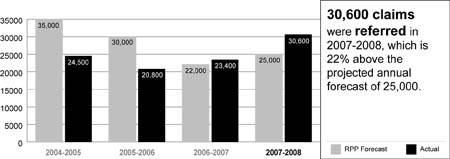
(Click on image to enlarge)
Note: The numbers have been rounded off to the nearest hundred.
The 2007-2008 referrals were 30% above the 2006-2007 totals and 46% above the 2005-2006 totals. Mexico remained the top source country for the fifth consecutive year, with 7,600 claims. Mexico claims accounted for 25% of all referrals. The 2007-2008 Mexican referrals were 37% more than the referrals in 2006-2007. Haiti claim referrals were 4,300, followed by Colombia as the third top source country, with 3,000 referrals. The Western hemisphere accounted for 60% of all claims referred in 2007-2008.
Claims finalized
Figure 2.2: Refugee Protection Claims Finalized
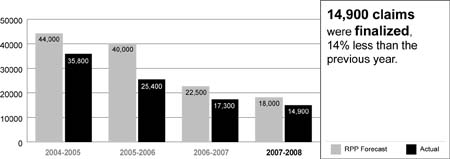
(Click on image to enlarge)
Note: The numbers have been rounded off to the nearest hundred.
Given the uncertainty surrounding the appointments and reappointments of decision-makers to the RPD, the IRB projected to finalize 16,000 to 20,000 refugee protection claims. In 2007-2008, the RPD finalized 14,900 claims.
During the reporting period, decision-makers' productivity was up 8% over last fiscal year. It was also the highest in three years and can be attributed to enhanced case management and adjudicative strategies. However, because fewer decision-makers were appointed and reappointed, the gains in productivity could not offset the shortfall in finalizations.
During 2007-2008, the RPD had an average of 79 decision-makers out of a funded complement of 127.
Claims waiting
Figure 2.3: Refugee Protection Claims Waiting
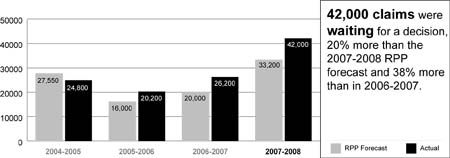
Note: The numbers have been rounded off to the nearest hundred.
Due to the increase in referrals and the drop in finalizations, on March 31, 2008, 42,000 claims were waiting for a decision versus the projected annual amount of 33,200. This is an increase of 16,000 claims waiting from the year before, and more than double from March 31, 2006.
Average processing time
The average processing time increased to 14 months in 2007-2008, versus the projected 12.5 months for the year. For the previous two fiscal years the average processing time was 12 months. The increased average processing time is due in part to a growing inventory and fewer experienced decision-makers. At year-end, close to 75% of claims finalized were older than a year, reflecting a rapidly growing, aging inventory and the RPD's decision to finalize the oldest claims in its inventory.
Average cost per claim finalized
The average cost per claim for 2007-2008 was $4,938, compared with $4,117 in 2006-2007. Unit costs per claim ranged from $2,200 for an expedited case to $7,300 for complex cases.
The increase in the average cost per claim is mainly attributable to a higher share of fixed business sustaining costs per unit caused by a lower volume of claims finalized during the year and increases in salary costs.
The actual cost per claim is slightly higher than the forecasted average cost of $4,700 (based on an estimate of 16,000 claim finalizations) as reported in the 2007-2008 Report on Plans and Priorities due to the factors noted above.
The cost per claim includes decision-making costs and costs of related activities such as case preparation, research, scheduling of hearings, legal services, foreign-language interpretation, technological support, translation services and administrative support. It also includes a share of the costs from the Corporate Management and Services program activity, which is allocated to the three decision-making program activities, based on expenditure trends.
Figure 2.4: Refugee Protection Master Graph
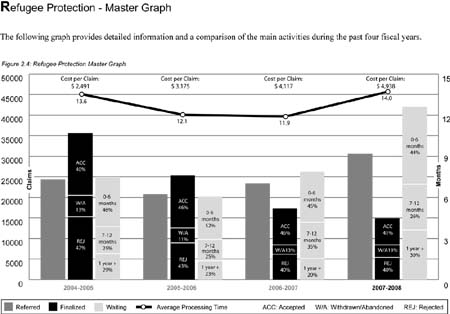
(Click on image to enlarge)
Admissibility Hearings and Detention Reviews Program Activity
| The Admissibility Hearings and Detention Reviews program activity holds hearings for foreign nationals or permanent residents who are alleged to be inadmissible to Canada pursuant to the provisions of the IRPA. Detention reviews are held concerning permanent residents and foreign nationals who are detained under the IRPA authority. Detainees must be seen by the Immigration Division within 48 hours and subsequent reviews must be conducted within specific timeframes as set out in the IRPA. Decision-makers must balance individuals' right to liberty with the security interests of Canadians and persons in Canada. |
Over the past 18 months, decision-maker turnover has reached 63% in the Central Region, and most decision-makers currently have one year or less of experience. Since the Central Region's workload represents approximately 60%�of the Division's total workload, every effort has been made to support our new decision-makers, including the invaluable contributions of decision-makers and directors in the other regions. I am extremely proud of this remarkable example of teamwork.
Ghislaine Charlebois
Director General Immigration Division |
Performance Measurements and Indicators
Table 2.5: Admissibility Hearings and Detention Reviews Program Activity Total Financial and Human Resources
| Financial Resources ($ millions) | ||
| Planned Spending | Total Authorities | Actual Spending |
| 15.2 | 17.3 | 12.7 |
| Human Resources (FTEs) | ||
| Planned | Actual | Difference |
| 90 | 92 | 2 |
Performance Highlights and Results
| The level of activity is dependent on the number of cases referred by the CBSA. Over the course of 2007-2008, the admissibility and detention reviews program activity coped with an increase in referrals for both admissibility hearings (9%) and detention reviews (4%).�The Immigration Division finalized 2,700 admissibility hearings in fiscal year 2007-2008, 17% more than the RPP forecast and 1% more than in the previous fiscal year. The Division finalized 16,050 detention reviews, 2% more than forecasted in the RPP and 2% more than finalized in 2006-2007. |
Table 2.6: Admissibility Hearings and Detention Reviews Program Activity Plans and Results
| Strategic Outcome: Provide Canadians with well-reasoned decisions on immigration and refugee matters efficiently, fairly and in accordance with the law | |
|
Strategic Priority 2 Continue to build an organization that strengthens its operational and leadership capacity, its diversity and its flexibility |
|
| Plans | Results |
| Distinct Elements and Tribunal Values | |
| Pursue succession recruitment efforts and integration of new decision-makers |
|
|
Strategic Priority 3 Continue to improve adjudicative and case management strategies including the implementation of Stage 1 of the Integrated Case Management System (ICMS) |
|
| Plans | Results |
| Distinct Elements and Tribunal Values | |
| Introduce and implement innovative approaches to processes by further developing and promoting tools that will support quality, consistency and efficiency in decision-making |
|
| Develop harmonized processes and adopt a more flexible resource management approach to help meet the legislative timeframes and operational requirements to achieve finalization of all cases referred to the Division in a timely fashion |
|
Key Outputs
The outputs for the Admissibility Hearings and Detention Reviews program activity are:
- Admissibility hearings finalized
- Detention reviews finalized
- Average cost per admissibility hearing finalized
- Average cost per detention review finalized
Admissiblity Hearings finalized
Figure 2.5: Admissibility Hearings Finalized
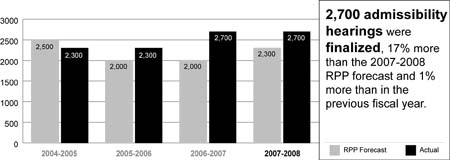
(Click on image to enlarge)
Note: The numbers have been rounded off to the nearest hundred.
Outcome of decisions
- 72% resulted in a removal order being issued because the person was determined inadmissible
- 3% resulted in permission to enter or to remain in Canada
- 7% were subject to the withdrawal of the inadmissibility allegation by the CBSA at the hearing
- 16% of persons who received a notice to appear at their hearing failed to appear and the case was closed
Detention Reviews finalized
Figure 2.6: Detention Reviews Finalized
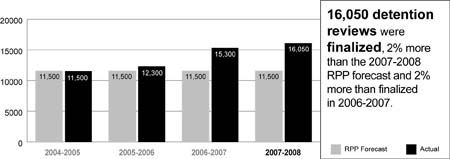
(Click on image to enlarge)
Note: Please note that starting in 2005-2006, the IRB included cases that were resolved before opening (RBOs) in its reporting on total finalizations. In 2005-2006, 10,950 detention reviews were finalized without RBO, 11,600 in 2006-2007 and 11,900 in 2007-2008. The numbers have been rounded off to the nearest hundred.
The ID received 16,200 requests for detention reviews from the CBSA in 2007-2008. The Division finalized 16,050 detention reviews; 2% more than forecasted in the 2007-2008 Report on Plans and Priorities and 2% more than finalized in 2006-2007. The remaining 150 cases were pending decisions.
The variance in the RPP forecast (11,500) and the actual number of detention reviews that were finalized (16,050) is attributable mainly to changes in the case management process. Cases resolved without a decision are now being included in the actual finalizations, as described below.
Of the 16,050 detention reviews finalized, 11,900 were finalized with a decision—a 2% increase over the 11,600 detention reviews finalized with a decision in 2006-2007. The remaining 4,150 were finalized without a decision either because the case was rescheduled or the person had been removed, released or detained by courts prior to a scheduled review.
Outcome of detention reviews finalized with a decision
- 74% resulted in continued detention
- 19% resulted in an offer to release, subject to certain terms and conditions
- 5% resulted in release orders without any terms or conditions attached
- 2% resulted in changes to the conditions imposed on persons granted release
Average cost per admissibility hearing and detention review finalized
The average cost per admissibility hearing finalized was $1,096 and the average cost per detention review finalized was $727. These costs are comparable to the actual average costs for 2006-2007 of $1,133 per admissibility hearing and $751 per detention review. As well, the average costs for 2007-2008 are in line with the forecasted cost indicated in the 2007-2008 Report on Plans and Priorities of $1,100 per admissibility hearing and $800 per detention review.
The cost per admissibility hearing and detention review includes decision-making costs and costs of related activities such as case preparation, research, scheduling of hearings, legal services, foreign-language interpretation, technological support, translation services and administrative support. It also includes a share of the costs from the Corporate Management and Services program activity, which is allocated to the three decision-making program activities, based on expenditure trends.
Figure 2.7: Admissibility Hearings Master Graph
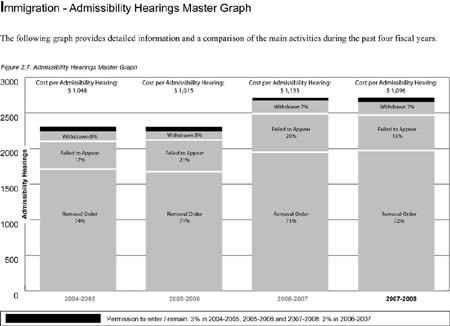
(Click on image to enlarge)
Figure 2.8: Detention Review Master Graph
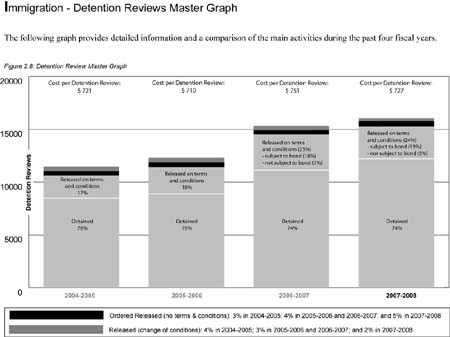
(Click on image to enlarge)
Immigration Appeal Program Activity
| The Immigration Appeal program activity hears immigration appeals from Canadian citizens and permanent residents whose applications to sponsor close family members to Canada have been refused. Other key functions include hearing appeals from permanent residents, foreign nationals with a permanent resident visa, protected persons who have been ordered removed from Canada and permanent residents outside of Canada who have not fulfilled their residency obligation. |
The Immigration Appeal Division achieved record-high productivity again in 2007-2008.�I want to acknowledge the dedication and hard work of our decision-makers and public service employees.�The quality of our work also remains high due to our ongoing professional development, implementation of our adjudication strategies and our comprehensive adjudicative support.
Shari Stein
A/Deputy Chairperson Immigration Appeal Division |
Performance Measurements and Indicators
Table 2.7: Immigration Appeal Program Activity Financial and Human Resources
| Financial Resources ($ millions) | ||
| Planned Spending | Total Authorities | Actual Spending |
| 13.0 | 16.3 | 15.2 |
| Human Resources (FTEs) | ||
| Planned | Actual | Difference |
| 120 | 139 | 19 |
The difference between planned and actual expenditures was mainly due to additionnal salaries and operating expenses in support of tribunal operations.
Performance Highlights and Results
| The IAD responded to continuing high caseload demands and decision-maker complement shortfalls with a year of record-high productivity. The momentum of the IAD Innovation transformation continued, with more improvements in case management and adjudicative support, further pilot projects and a major focus on conducting hearings in a more proactive manner.�The challenge of the IAD Central Region backlog was addressed through an aggressive backlog reduction plan, including regional sharing of decision-makers from Eastern Region.�This resulted in completing the oldest cases in our case inventory in Toronto. |
Table 2.8: Immigration Appeal Program Activity Plans and Results
| Strategic Outcome: Provide Canadians with well-reasoned decisions on immigration and refugee matters efficiently, fairly and in accordance with the law | |
|
Strategic Priority 3 Continue to improve adjudicative and case management strategies including the implementation of Stage 1 of the Integrated Case Management System (ICMS) |
|
| Plans | Results |
| Distinct Elements and Tribunal Values | |
| IAD Innovation – Continued implementation of IAD Innovation proposals to transform IAD into a more flexible and proactive division |
|
| Early Information Gathering and Early Informal Resolution – Obtain more information from both parties earlier, to support earlier screening, streaming and resolution |
|
| Alternative dispute resolution (ADR) – Finish transition of ADR program to public service, and increase early informal resolution through successful ADR by public service employees |
|
| Hearings – Ensure files are hearing-ready and have hearings conducted in a more proactive manner |
|
| Adjudication strategy and consistency – Develop and promote consistent and strategic approaches, including in areas such as removal order appeals and stays, proactive hearings, adjournments and postponements, and the applicant's testimony in marriage sponsorship appeals |
|
Key Outputs
The outputs for the Immigration Appeal program activity are:
- Appeals filed
- Appeals finalized
- Appeals waiting
- Average processing time
- Average cost per appeal finalized
Appeals filed
Figure 2.9: Immigration Appeals Filed
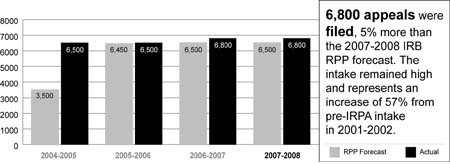
(Click on image to enlarge)
Note: The numbers have been rounded off to the nearest hundred.
The number of filed appeals remained high due to an increase in removal order appeals. Sponsorship appeals filed decreased only marginally by 1 percent from the previous fiscal year.
Appeals finalized
Figure 2.10: Immigration Appeals Finalized
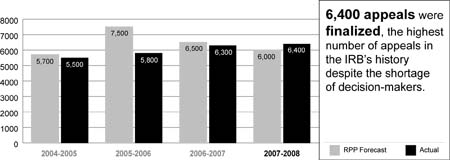
(Click on image to enlarge)
Note: The numbers have been rounded off to the nearest hundred.
Given the uncertainty surrounding the appointments and reappointments of decision-makers to the IAD, the IRB projected to finalize 5,800 to 6,300 appeals. A total of 6,400 appeals were finalized in 2007-2008, the highest number of appeals in the IRB's history.
Higher numbers of appeals were finalized despite the decrease in the decision-maker complement. The average decision-maker complement in 2007-2008 was 25, out of an authorized 37, the lowest since 2001-2002.
The IAD developed adjudication strategies to deal with its caseload and issues in a strategic and consistent manner. Several initiatives were implemented throughout 2007-2008 such as improved pre-hearing actions to ensure files are hearing ready and strategic sharing of decision-makers across the regions. The continued high productivity of decision-makers and the increase in public service support for the IAD contributed to an increased level of performance. The IAD focused on training decision-makers to conduct hearings in a more proactive manner. The large pending inventory in the Central Region was addressed through an aggressive backlog reduction initiative. One of several innovative measures and pilot projects was a new case stream for residency obligation appeals selected by the CBSA in which the Minister's counsel would not appear in person at the hearing but would instead provide written submissions. Successful use of the Alternative Dispute Resolution (ADR) program, the early review processes, and increased focus on the screening and streaming of cases were key mechanisms by which the IRB managed its immigration appeals caseload and which had a positive impact on productivity.
Outcome of decisions
Of the 6,400 appeals finalized in 2007-2008:
- 39% were allowed
- 31% were dismissed
- 30% were either withdrawn by the appellant or declared abandoned by the IRB
In addition to the appeals finalized, IAD decision-makers ordered 700 stays, a temporary outcome in a removal order appeal in which reconsideration and final decision is done at a later date.
These results have fluctuated slightly over the past few years, as outcomes are a function of the nature of the appeals being heard, with each case being decided independently on its particular merits.
Appeals waiting
Figure 2.11: Immigration Appeals Waiting
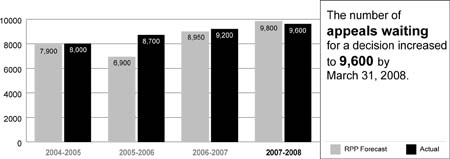
(Click on image to enlarge)
Note: The numbers have been rounded off to the nearest hundred.
The number of appeals waiting for a decision increased to 9,600 by March 31, 2008. (This includes 1,340 removal order appeals in which the removal order has been stayed and the appeal is waiting for reconsideration and a final decision later). The increased number of appeals waiting for a decision is a result of the number of appeals filed exceeding the number of appeals finalized for a fifth consecutive year.
Average processing time
The average processing time for appeals increased by 3% in 2007-2008 to 10.1 months nationally in comparison with 2006-2007. The average processing time has been increasing for the past four consecutive years. The increasing processing time is a result of the number of appeals filed exceeding the number of appeals finalized. Increased caseload and delays in decision-maker appointments and reappointments have been contributing factors to increased inventory levels and average processing time.
Average cost per appeal finalized
The overall average cost per finalized appeal for 2007-2008 of $2,330 is comparable to the 2006-2007 actual average cost of $2,260. Average unit costs per appeal were $2,200 for removal orders, $2,300 for sponsorship appeals and $2,500 for residency obligation appeals.
The overall average cost per finalized appeal is slightly higher than the forecasted cost of $2,200 as reported in the 2007-2008 Report on Plans and Priorities primarily due to increased salary costs.
The cost per appeal includes decision-making costs and costs of related activities such as case preparation, scheduling of hearings, legal services, foreign-language interpretation, technological support, translation services and administrative support. It also includes a share of the costs of the Corporate Management and Services program activity, which is allocated to the three decision-making program activities, based on expenditure trends.
Figure 2.12: Immigration Appeal Master Graph
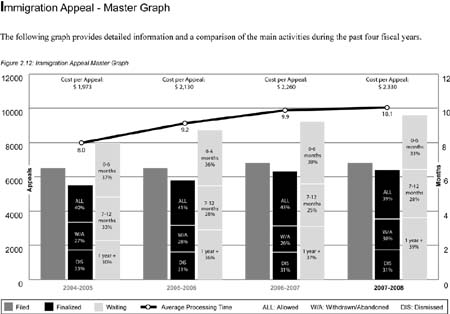
(Click on image to enlarge)
